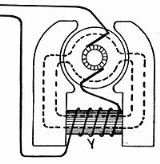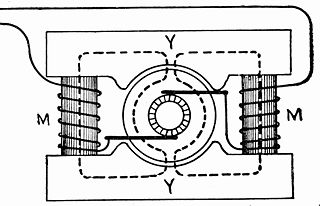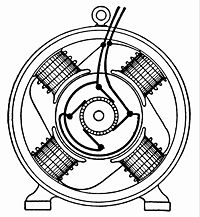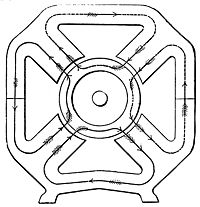
Field coil
Encyclopedia
A field coil is a component of an electro-magnetic machine, typically a rotating electrical machine
such as a motor
or generator
. A current-carrying coil is used to generate a magnetic field.
Magnetic fields require a continuous circuit, thus more than one pole. Most arrangements use one field coil per pole. Some older or simpler arrangements use a single field coil with a pole at each end.
Although field coils are most commonly found in rotating machines, they are also used, although not always with the same terminology, in many other electromagnetic machines. These include simple electromagnet
s through to complex lab instruments such as mass spectrometers and NMR machine
s.
field coils generate a constant, static field. Most three-phase
AC field coils are used to generate a rotating field as part of an electric motor
. Single-phase AC
motors may follow either of these patterns: small motors are usually universal motors, like the brushed DC motor with a commutator, but run from AC. Larger AC motors are generally induction motors, whether these are three- or single-phase.
The field coils can be mounted on either the rotor
or the stator
, depending on whichever method is the most cost-effective for the device design.
For electric motors, the field is mounted on the stator. In a brushed DC motor the field is static but the armature current must be commutated, so as to continually rotate. This is done by supplying the armature windings on the rotor through a commutator
, a combination of rotating slip ring and switches. AC induction motors also use field coils on the stator, the current on the rotor being supplied by induction in a squirrel cage
.
For generators, the field current is smaller than the output current.Strictly it is the output power that is greater than the field power, although in practice this usually implies that the current is greater too. Accordingly the field is mounted on the rotor and suppplied through slip rings. The output current is taken from the stator, avoiding the need for high-current sliprings. In DC generators, which are now generally obsolete in favour of AC generators with rectifiers, the need for commutation meant that brushgear and commutators could still be required. For the high-current, low-voltage generators used in electroplating
, this could require particularly large and complex brushgear.
In the early years of generator development, the stator field went through an evolutionary improvement from a single bipolar
field to a later multipole design.
Bipolar generators were universal prior to 1890 but in the years following it was replaced by the multipolar field magnets. Bipolar generators were then only made in very small sizes.
The stepping stone between these two major types was the consequent-pole bipolar generator, with two field coils arranged in a ring around the stator.
This change was needed because higher voltages allow current to flow greater distances over small wires. To increase the output voltage, a DC
generator must be spun faster, but beyond a certain speed this is impractical for very large power transmission generators.
By increasing the number of pole faces surrounding the Gramme ring, the ring can be made to cut across more magnetic lines of force in one revolution than a basic two-pole generator. Consequently a four-pole generator could output twice the voltage of a two-pole generator, a six-pole generator could output three times the voltage of a two-pole, and so forth. This allows output voltage to increase without also increasing the rotational rate.
In a multipolar generator, the armature
and field magnets are surrounded by a circular frame or "ring yoke" to which the field magnets are attached. This has the advantages of strength, simplicity, symmetrical appearance, and minimum magnetic leakage, since the pole pieces have the least possible surface and the path of the magnetic flux
is shorter than in a two-pole design
copper wire, sometimes termed magnet wire
. The winding material must have a low resistance, to reduce the power consumed by the field coil, but more importantly to reduce the waste heat produced by ohmic heating. Excess heat in the windings is a common cause of failure. Owing to the increasing cost of copper, aluminium windings are increasingly used.
An even better material than copper, except for its high cost, would be silver as this has even lower resistivity
. Silver has been used in rare cases. During World War II
the Manhattan project
to build the first atomic bomb used electromagnetic devices known as calutron
s to enrich uranium. Thousands of tons of silver were borrowed from the U.S. Treasury reserves to build highly-efficient low-resistance field coils for their magnets.
Electrical machine
An electrical machine is the generic name for a device that converts mechanical energy to electrical energy, converts electrical energy to mechanical energy, or changes alternating current from one voltage level to a different voltage level....
such as a motor
Electric motor
An electric motor converts electrical energy into mechanical energy.Most electric motors operate through the interaction of magnetic fields and current-carrying conductors to generate force...
or generator
Electrical generator
In electricity generation, an electric generator is a device that converts mechanical energy to electrical energy. A generator forces electric charge to flow through an external electrical circuit. It is analogous to a water pump, which causes water to flow...
. A current-carrying coil is used to generate a magnetic field.
Magnetic fields require a continuous circuit, thus more than one pole. Most arrangements use one field coil per pole. Some older or simpler arrangements use a single field coil with a pole at each end.
Although field coils are most commonly found in rotating machines, they are also used, although not always with the same terminology, in many other electromagnetic machines. These include simple electromagnet
Electromagnet
An electromagnet is a type of magnet in which the magnetic field is produced by the flow of electric current. The magnetic field disappears when the current is turned off...
s through to complex lab instruments such as mass spectrometers and NMR machine
Nuclear magnetic resonance
Nuclear magnetic resonance is a physical phenomenon in which magnetic nuclei in a magnetic field absorb and re-emit electromagnetic radiation...
s.
Fixed and rotating fields
MostField coils are found in a vast array of electrical machines and so any attempt to categorise them in a readable manner is likely to exclude some obscure examples. DCDirect current
Direct current is the unidirectional flow of electric charge. Direct current is produced by such sources as batteries, thermocouples, solar cells, and commutator-type electric machines of the dynamo type. Direct current may flow in a conductor such as a wire, but can also flow through...
field coils generate a constant, static field. Most three-phase
Three-phase electric power
Three-phase electric power is a common method of alternating-current electric power generation, transmission, and distribution. It is a type of polyphase system and is the most common method used by grids worldwide to transfer power. It is also used to power large motors and other heavy loads...
AC field coils are used to generate a rotating field as part of an electric motor
Induction motor
An induction or asynchronous motor is a type of AC motor where power is supplied to the rotor by means of electromagnetic induction. These motors are widely used in industrial drives, particularly polyphase induction motors, because they are robust and have no brushes...
. Single-phase AC
Alternating current
In alternating current the movement of electric charge periodically reverses direction. In direct current , the flow of electric charge is only in one direction....
motors may follow either of these patterns: small motors are usually universal motors, like the brushed DC motor with a commutator, but run from AC. Larger AC motors are generally induction motors, whether these are three- or single-phase.
Stators and rotors
Many rotary electrical machines require current to be conveyed to (or extracted from) a moving rotor, usually by means of brushgear. This brushgear is often the most complex and least reliable part of such a machine. It may also represent a limit on the maximum current that the machine can handle. For this reason, when machines must use two sets of windings, the windings carrying the least current are usually placed on the rotor and those with the highest current on the stator.The field coils can be mounted on either the rotor
Rotor (electric)
The rotor is the non-stationary part of a rotary electric motor, electric generator or alternator, which rotates because the wires and magnetic field of the motor are arranged so that a torque is developed about the rotor's axis. In some designs, the rotor can act to serve as the motor's armature,...
or the stator
Stator
The stator is the stationary part of a rotor system, found in an electric generator, electric motor and biological rotors.Depending on the configuration of a spinning electromotive device the stator may act as the field magnet, interacting with the armature to create motion, or it may act as the...
, depending on whichever method is the most cost-effective for the device design.
For electric motors, the field is mounted on the stator. In a brushed DC motor the field is static but the armature current must be commutated, so as to continually rotate. This is done by supplying the armature windings on the rotor through a commutator
Commutator
In mathematics, the commutator gives an indication of the extent to which a certain binary operation fails to be commutative. There are different definitions used in group theory and ring theory.-Group theory:...
, a combination of rotating slip ring and switches. AC induction motors also use field coils on the stator, the current on the rotor being supplied by induction in a squirrel cage
Squirrel cage rotor
A squirrel cage rotor is the rotating part used in the most common form of AC induction motor. An electric motor with a squirrel cage rotor is termed a squirrel cage motor.- Structure :In overall shape, it is a cylinder mounted on a shaft...
.
For generators, the field current is smaller than the output current.Strictly it is the output power that is greater than the field power, although in practice this usually implies that the current is greater too. Accordingly the field is mounted on the rotor and suppplied through slip rings. The output current is taken from the stator, avoiding the need for high-current sliprings. In DC generators, which are now generally obsolete in favour of AC generators with rectifiers, the need for commutation meant that brushgear and commutators could still be required. For the high-current, low-voltage generators used in electroplating
Electroplating
Electroplating is a plating process in which metal ions in a solution are moved by an electric field to coat an electrode. The process uses electrical current to reduce cations of a desired material from a solution and coat a conductive object with a thin layer of the material, such as a metal...
, this could require particularly large and complex brushgear.
Bipolar and multipolar fields
 |
|
 |
 |
In the early years of generator development, the stator field went through an evolutionary improvement from a single bipolar
Bipolar electric motor
A bipolar electric motor is an electric motor with only two poles to its stationary field. They are an example of the simple brushed DC motor, with a commutator. This field may be generated by either a permanent magnet or a field coil....
field to a later multipole design.
Bipolar generators were universal prior to 1890 but in the years following it was replaced by the multipolar field magnets. Bipolar generators were then only made in very small sizes.
The stepping stone between these two major types was the consequent-pole bipolar generator, with two field coils arranged in a ring around the stator.
This change was needed because higher voltages allow current to flow greater distances over small wires. To increase the output voltage, a DC
Direct current
Direct current is the unidirectional flow of electric charge. Direct current is produced by such sources as batteries, thermocouples, solar cells, and commutator-type electric machines of the dynamo type. Direct current may flow in a conductor such as a wire, but can also flow through...
generator must be spun faster, but beyond a certain speed this is impractical for very large power transmission generators.
By increasing the number of pole faces surrounding the Gramme ring, the ring can be made to cut across more magnetic lines of force in one revolution than a basic two-pole generator. Consequently a four-pole generator could output twice the voltage of a two-pole generator, a six-pole generator could output three times the voltage of a two-pole, and so forth. This allows output voltage to increase without also increasing the rotational rate.
In a multipolar generator, the armature
Armature (electrical engineering)
In electrical engineering, an armature generally refers to one of the two principal electrical components of an electromechanical machine–generally in a motor or generator, but it may also mean the pole piece of a permanent magnet or electromagnet, or the moving iron part of a solenoid or relay....
and field magnets are surrounded by a circular frame or "ring yoke" to which the field magnets are attached. This has the advantages of strength, simplicity, symmetrical appearance, and minimum magnetic leakage, since the pole pieces have the least possible surface and the path of the magnetic flux
Magnetic flux
Magnetic flux , is a measure of the amount of magnetic B field passing through a given surface . The SI unit of magnetic flux is the weber...
is shorter than in a two-pole design
Winding materials
Coils are typically wound with enamelledEnameled wire
Enamelled wire is wire coated with a very thin insulating layer. It is used in applications such as winding electric motor coils, speakers and transformers. It is also used in the construction of electromagnets and inductors....
copper wire, sometimes termed magnet wire
Magnet wire
Magnet wire or enameled copper wire is a copper or aluminum wire covered with thin insulation. It is used in the construction of transformers, inductors, motors, headphones, loudspeakers, hard drive head positioners, potentiometers, and electromagnets, among other applications...
. The winding material must have a low resistance, to reduce the power consumed by the field coil, but more importantly to reduce the waste heat produced by ohmic heating. Excess heat in the windings is a common cause of failure. Owing to the increasing cost of copper, aluminium windings are increasingly used.
An even better material than copper, except for its high cost, would be silver as this has even lower resistivity
Resistivity
Electrical resistivity is a measure of how strongly a material opposes the flow of electric current. A low resistivity indicates a material that readily allows the movement of electric charge. The SI unit of electrical resistivity is the ohm metre...
. Silver has been used in rare cases. During World War II
World War II
World War II, or the Second World War , was a global conflict lasting from 1939 to 1945, involving most of the world's nations—including all of the great powers—eventually forming two opposing military alliances: the Allies and the Axis...
the Manhattan project
Manhattan Project
The Manhattan Project was a research and development program, led by the United States with participation from the United Kingdom and Canada, that produced the first atomic bomb during World War II. From 1942 to 1946, the project was under the direction of Major General Leslie Groves of the US Army...
to build the first atomic bomb used electromagnetic devices known as calutron
Calutron
A calutron is a mass spectrometer used for separating the isotopes of uranium. It was developed by Ernest O. Lawrence during the Manhattan Project and was similar to the cyclotron invented by Lawrence. Its name is a concatenation of Cal. U.-tron, in tribute to the University of California,...
s to enrich uranium. Thousands of tons of silver were borrowed from the U.S. Treasury reserves to build highly-efficient low-resistance field coils for their magnets.

